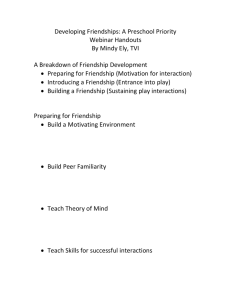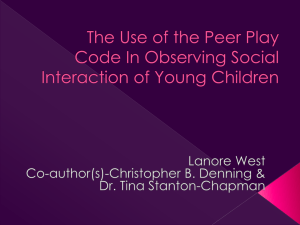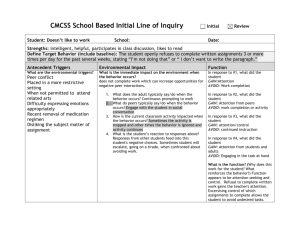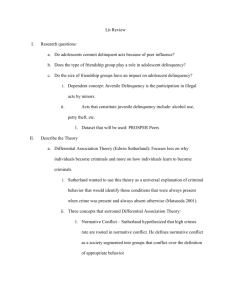antonishak proposal
advertisement
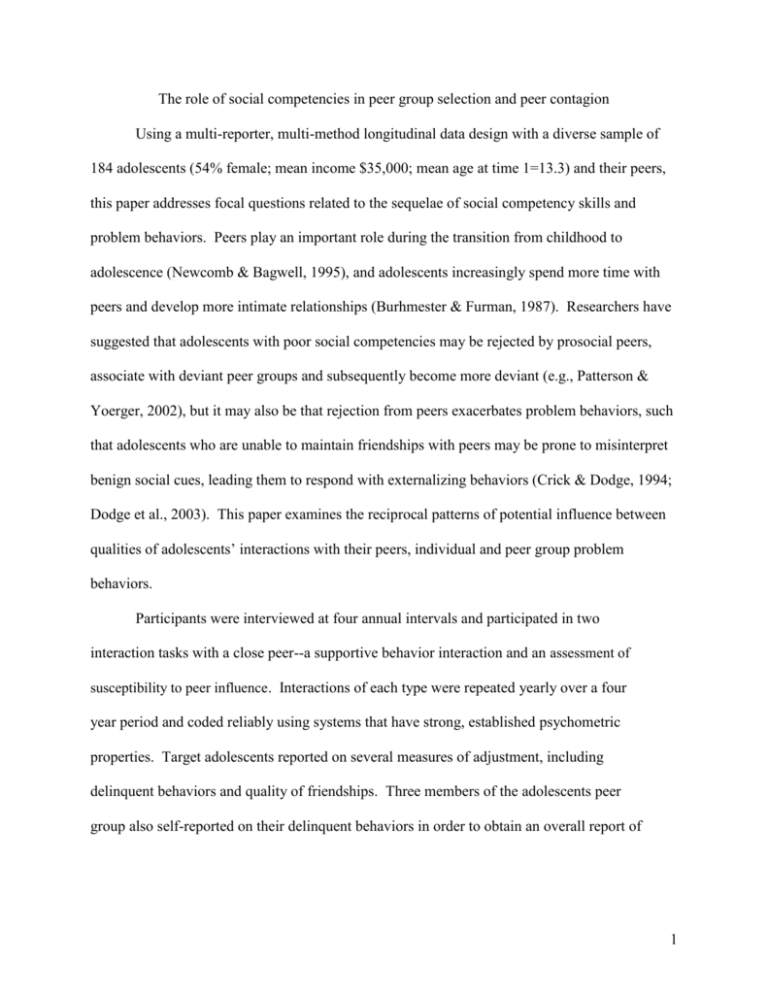
The role of social competencies in peer group selection and peer contagion Using a multi-reporter, multi-method longitudinal data design with a diverse sample of 184 adolescents (54% female; mean income $35,000; mean age at time 1=13.3) and their peers, this paper addresses focal questions related to the sequelae of social competency skills and problem behaviors. Peers play an important role during the transition from childhood to adolescence (Newcomb & Bagwell, 1995), and adolescents increasingly spend more time with peers and develop more intimate relationships (Burhmester & Furman, 1987). Researchers have suggested that adolescents with poor social competencies may be rejected by prosocial peers, associate with deviant peer groups and subsequently become more deviant (e.g., Patterson & Yoerger, 2002), but it may also be that rejection from peers exacerbates problem behaviors, such that adolescents who are unable to maintain friendships with peers may be prone to misinterpret benign social cues, leading them to respond with externalizing behaviors (Crick & Dodge, 1994; Dodge et al., 2003). This paper examines the reciprocal patterns of potential influence between qualities of adolescents’ interactions with their peers, individual and peer group problem behaviors. Participants were interviewed at four annual intervals and participated in two interaction tasks with a close peer--a supportive behavior interaction and an assessment of susceptibility to peer influence. Interactions of each type were repeated yearly over a four year period and coded reliably using systems that have strong, established psychometric properties. Target adolescents reported on several measures of adjustment, including delinquent behaviors and quality of friendships. Three members of the adolescents peer group also self-reported on their delinquent behaviors in order to obtain an overall report of 1 peer group problem behavior. Additionally, the three peer reporters completed measures of friendship quality about their relationship with the target teen. To capture the dynamic relationships between friendship quality and individual and peer group problem behaviors, we utilize latent difference score models (LDS, See Figure 1). LDS models offer promising ways to examine how change within one context or individual affects changes within another context or individual (Nesselroade & Ram, 2004), by considering the time-ordered relationships between variables. The coupling parameters of the model provide information about how changes in friendship quality are related to changes in adjustment. For example, it may be that a) changes in friendship quality are related to changes in delinquency; b) changes in delinquency may be related to changes in friendship quality; or c) changes in delinquent behaviors and friendship quality are reciprocally related. Results confirm relationships between friendship quality and delinquent behaviors. For example, best-fitting models for friendship quality are presented in Table 1, with reciprocal relationships between friendship quality and the target adolescents’ delinquency. Additionally, increases in friendship quality were related to decreases in the mean level of the peer group’s externalizing behaviors. Adolescents’ assertiveness and intimacy in interactions with a close friend were also linked in expected directions to the target teen and his/her peer groups’ delinquency. Results are interpreted as suggesting a transactional pattern of friendship quality, peer influence, and problem behaviors. 2 σy y 0* y1 y2 y3 y1 y2 y3 βy y0 σy0,xs σx0,y0 Δy2 αy ys* ys γx K xs xs* βy γy Δy3 γx αx Δx2 σx0,ys x0 βx x0* γy Δx3 βx x1 x2 x3 x1 x2 x3 ex Figure 1. Latent Difference Score model, where x0, y0=mean of latent initial levels, x0*, y0*=standardized mean of latent initial levels; ∆y[t], ∆x[t]=latent changes at time t, yx,ys=mean of latent slope, yx*,ys*=standardized mean of latent slope, α=slope loadings (linear model), σ x0xs=correlation between x latent initial level and slope, σ x0xs=correlation between y latent initial level and slope, σ y0xs=correlation between y latent initial level and x slope; σ y0x0=correlation between x and y initial level; σ ysxs=correlation between x and y slope, βx and βy self-feedback parameters both coupling parameters (γy and γx). 3 Table 1. LDS parameters for friendship quality in relationships and self and peer group reported delinquency. Self-report of .24 (2.0) ns ns delinquency CFI=.94, RMSEA=.04 Peer group delinquency .28* ns ns CFI=.95, RMSEA=.06 (2.1) Numbers in parenthesis represent t-values; *p<.05, **p<.01 Couplings Friend quality slope w/ delinquency slope Friend quality Slope w/ delinquency level Friend quality level w/ delinquency slope Friend quality level w/ delinquency level Correlations Friend. quality delin. Delinq Friend. quality ns -2.28* (2.4) -2.21* (2.2) ns -2.26* (2.3) ns 4


